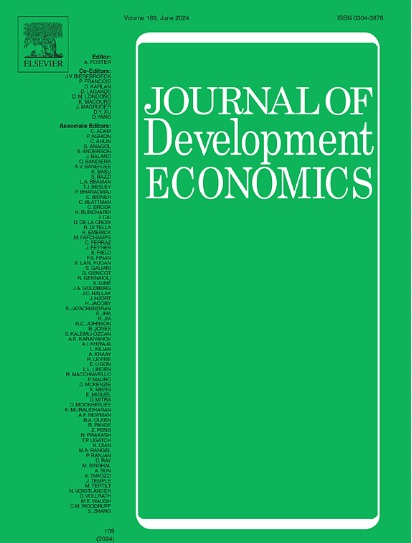评估多维发展弹性
IF 4.6
1区 经济学
Q1 ECONOMICS
引用次数: 0
摘要
现有的复原力衡量标准通常基于单一的福祉指标。在家庭面临多方面贫困的情况下,这是一个问题。我们将基于概率矩的弹性测量方法与多维贫困测量方法相结合,开发了一个多维弹性测量方法。将这些数据应用到埃塞俄比亚的家庭面板数据中,我们发现,基于基于支出的贫困、饮食多样性和牲畜资产持有的单变量和多维弹性措施可以对家庭排名以及发展干预措施的潜在影响产生不同的推断。利用消费支出、饮食多样性和牲畜资产持有量构建的单变量弹性指标显示出不同的时空分布模式。但是,虽然单变量测量之间以及与不同的幸福指标之间的相关性很弱,但多变量测量显示出更强的等级相关性。当我们将单变量弹性测量与多维弹性测量进行对比时,我们发现后者在研究期间变化较小;多维复原力措施似乎更多地反映了家庭的“持续性或结构性”脆弱性和相关能力。我们还展示了这些单变量和多变量测量的差异,包括支持目标过程的复合多维弹性测量的潜力。本文章由计算机程序翻译,如有差异,请以英文原文为准。
Estimating multidimensional development resilience
Existing measures of resilience are typically based on a single well-being indicator. This is problematic in contexts where households face deprivations across multiple dimensions. We develop a multidimensional resilience measure, integrating probabilistic moment-based resilience measurement approaches with multidimensional poverty measurement methods. Applying these to household panel data from Ethiopia, we show that univariate and multidimensional resilience measures based on expenditure-based poverty, dietary diversity, and livestock asset holdings can yield varied inferences on the ranking of households as well as potential impact of development interventions. Univariate resilience measures constructed using consumption expenditure, dietary diversity and livestock asset holdings show distinct temporal and spatial distributional patterns. But while univariate measures are weakly correlated with one another and with different well-being metrics, multivariate measures exhibit much stronger rank correlations. When we contrast univariate measures of resilience to multidimensional measures of resilience, we find that the latter vary less over the study period; multidimensional resilience measures seem to capture more “persistent or structural” vulnerability and associated capacity of households. We also demonstrate the differences in these univariate and multivariate measures, including the potential of the composite multidimensional resilience measures for supporting targeting processes.
求助全文
通过发布文献求助,成功后即可免费获取论文全文。
去求助
来源期刊

Journal of Development Economics
ECONOMICS-
CiteScore
8.30
自引率
4.00%
发文量
126
审稿时长
72 days
期刊介绍:
The Journal of Development Economics publishes papers relating to all aspects of economic development - from immediate policy concerns to structural problems of underdevelopment. The emphasis is on quantitative or analytical work, which is relevant as well as intellectually stimulating.
 求助内容:
求助内容: 应助结果提醒方式:
应助结果提醒方式:


